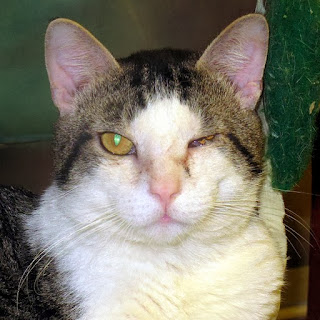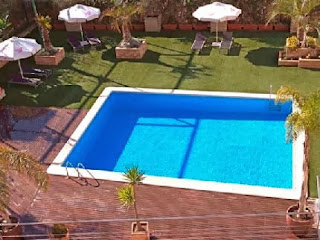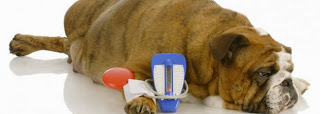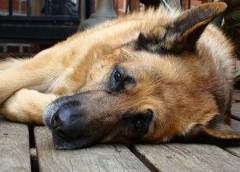Es una inflamación o infección de la conjuntiva de los párpados, bordes de la córnea y el interior del ojo, que provoca el enrojecimiento de uno o de los dos ojos y, en algunos casos edema o quemosis de la conjuntiva que puede producir que ésta sobresalga del ojo por su inflamación.
La secreción lagrimal puede aumentar, lo que provocará una secreción oftálmica acuosa que puede variar desde serosa hasta purulenta.
Se podrá observar un cambio en el color y la forma del iris, opacidad de las córneas y el ojo estará semicerrado o totalmente cerrado por el dolor.
En los gatos la mayoría de los problemas oculares están asociados a enfermedades sistémicas. Según la evolución la enfermedad podrá ser aguda o crónica, y puede comenzar en forma unilateral o bilateral.
Las conjuntivitis pueden ser alérgicas, traumáticas, paraistarias o infecciosas:
- Inflamación interna del ojo - uveítis- por Virus de leucemia felina, inmunodeficiencia felina, peritonitis infecciosa felina y toxoplasmosis.
- Alteraciones oncológicas como el carcinoma de células escamosas de los gatos blancos, cuando afecta a los párpados, y el linfoma ocular.
- Hipertensión sistémica.
- Enfermedades infecciosas como el Virus de la Rinotraqueítis Felina, Calicivirus felino o Clamidias.
- Cuerpos extraños, traumatismos, golpes, arañazos o quemaduras.
- Problemas hereditarios de algunas razas.
Los signos clínicos generales y locales, ayudarán al veterinario a diferenciar si la enfermedad es infecciosa sistémica o solo del ojo.
Las observaciones con lentes de aumento y luz especial pueden definir el tipo de lesión en el ojo. Además de, aparatos para medir la presión intraocular y métodos para medir el nivel de lágrimas.
Existen muchos tratamientos y medicamentos para tratar local y sistémicamente la enfermedad, en algunos casos también serán posibles los tratamientos quirúrgicos. No obstante, habrá que hacer un diagnóstico correcto para saber cuál es el tratamiento más adecuado para el animal.
La conjuntivitis, en la mayoría de los casos, anuncia la llegada de enfermedades más graves que pueden poner en peligro la vida del gato.
Por eso son tan importante las vacunas que previenen las virosis respiratorias que suelen presentar problemas oftalmológicos.
Es importante que los dueños se abstengan de realizar curaciones caseras al animal y acudan a su veterinarios para que realice un diagnóstico correcto de la o de las posibles enfermedades.
Is an inflammation or infection of the conjunctiva of the eyelids , edges of the cornea and inside the eye , causing redness of one or both eyes and in some edema cases or chemosis of conjunctiva can cause it will protrude eye by inflammation.
The tear secretion may increase , causing an aqueous ophthalmic secretion which may vary from serous to purulent .
It will see a change in the color and shape of the iris, corneal opacity and eye will be fully closed or semi-closed pain.
In cats the most eye problems are associated with systemic diseases. According to evolution the disease may be acute or chronic , and may begin unilaterally or bilaterally .
Conjunctivitis may be allergic , traumatic , or infectious paraistarias :
- Internal eye inflammation - uveitis - by feline leukemia virus , feline immunodeficiency virus , feline infectious peritonitis and toxoplasmosis.
- Oncological disorders as squamous cell carcinoma of the white cats, when it affects the eyelids, and ocular lymphoma.
- Systemic hypertension .
- Infectious diseases such as feline rhinotracheitis virus , feline calicivirus and Chlamydia .
- Foreign bodies , trauma, shock, scratches or burns.
- Hereditary problems of some breeds .
- The general and local clinical signs help the veterinarian to differentiate whether the disease is infectious or systemic eye only .
Observations with magnifying glasses and special light can define the type of eye injury . In addition , apparatus for measuring intraocular pressure and methods to measure the level of tears.
There are many treatments and medicines to treat the disease locally and systemically , in some cases also be possible surgical treatments . However , we must make a correct to know what is best for the animal treatment diagnosis.
Conjunctivitis , in most cases , announces the arrival of more serious diseases that can endanger the life of the cat .
Why are so important vaccines that prevent respiratory viruses that often have eye problems .
It is important that owners refrain from animal homemade cures and go to their veterinarians to make a correct diagnosis of the disease or possible .





























